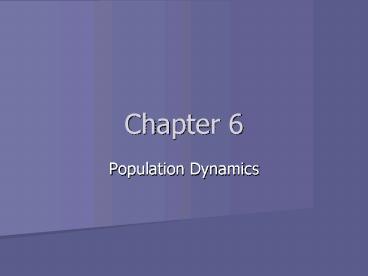Population Dynamics - PowerPoint PPT Presentation
1 / 43
Title:
Population Dynamics
Description:
Natural disasters or extreme weather events can help or hurt a population ... Weather Patterns with a Global Impact! Do these occurrences really REGULATE the ... – PowerPoint PPT presentation
Number of Views:62
Avg rating:3.0/5.0
Title: Population Dynamics
1
Chapter 6
- Population Dynamics
2
Objective 1 2
- Appreciate the potential of exponential growth
- Draw a diagram of the J and S curves and explain
what they mean
3
What is Exponential Growth?
4
Which Type of Growth is which?
5
Which is Which?
6
Geometric vs. Arithmetic Growth
- Geometric growth
- Population growth rate is expressed as a
fraction the population is calculated by
multiplying (J curve results) - SLOW AT FIRST, THEN HUGE GAINS!!!!!!!!!!
- Arithmetic growth
- The population is growth at a constant amount per
time. (linear curve results) - STEADY RISE IN POPULATION
7
Are both found here?
8
What does this graph say?
9
What is a J CURVE?
- Short gains early
- Big gains later
- Population is meeting/exceeding biotic potential
- Theoretical unchecked growth
- This is real for some populations (bacteria in
particular..but not ALWAYS!)
10
What is an S CURVE?
- The result of a population growth that has
experienced environmental resistance. - NOTE what happens to the influence of Env.
Resistance as the population approaches the
carrying capacity?
11
What factors can we glean fromthe S (Sigmoidal)
curve?
- All populations have some limits.
- Reading a S curve can reveal those limits or at
least give you an idea that are limits to look
for. - What limited our growth for so long????
12
Objective 3
- Who was Thomas Malthus and what did he say about
population growth?
13
Thomas Malthus
- 18th century Economist link to article
- Elevated as man is above all other animals by
intellectual faculties, it is not to be supposed
that the physical laws to which he is subjected
should be essentially different from those which
are observed to prevail in other parts of
animated nature. He may increase slower than most
other animals, but food is equally necessary to
his support and if this natural capacity of
increase be greater than can be permanently
supplied with food from a limited territory, his
increase must be constantly retarded by the
difficulty of procuring the means of
subsistence.
14
(No Transcript)
15
Population Oscillations
16
So what did he say?
- Populations are cyclic
- They will flux with the environment
- Famine, disease, warall affect population
17
Europe 0-2000
18
And the US?
19
Populations go thru one of two types of growth
- Irruptive or Malthusian Growth (unstable)
- Peaks, diebacks
- OR
- Logistic growth (stable)
- Constantly changing rate
- Be able to discuss
- the pros and cons of each.
20
Objective 4
- Discuss environmental resistance and discuss how
it can lead to logistic or stable growth
21
Malthusian Strategies
- Low tropic levels, pioneer species, primary
succession - Move into disturbed environs, mature early, make
many offspring, dont care for them, rely on
sheer numbers - Insects, rodents, parasites, annual plants
- Limited by predators, overshoot/diebacks, adapt
quickly - Extrinsic characteristics (pg. 129)
22
Logistic Strategies
- Larger, live longer, mature more slowly, produce
less offspring, have fewer predators, care for
offspring longer - Wolves, elephants, bears, primates
- intrinsic characteristics (pg. 129)
23
Objective 5
- Define fecundity, fertility, birth rates, life
expectancy, death rates, survivorship
24
Fecundity
- The physical ability to reproduce
25
Natality
- Producing of new individuals through hatching,
birth, germination or cloning
26
fertility
- A measure of the offspring produced
27
Birth Rates
- Crude birth rates for many countries is
declining..
28
Life expectancy
- Life expectancy calculator
- Living to 100
29
Death rates
- Causes of Death Number of Deaths Rate per
100,000 - 15-24 years
- All causes 32,699
- Accidents and adverse effects 13,872
- Motor vehicle accidents 10,624
- All other accidents and adverse effects 3,248
- Homicide and legal intervention 6,548
- Suicide 4,369
- Malignant neoplasms, including neoplasms of
lymphatic and hematopoietic tissues1,642 - Diseases of heart 920
- Human immunodeficiency virus infection 420
- Congenital anomalies 387
- Chronic obstructive pulmonary diseases and allied
conditions 230 - Pneumonia and influenza 197
- Cerebrovascular diseases 174
- All other causes (Residual) 3,940
- More death rate statistics
- Countries death rates
30
survivorship
- The percentage of offspring born at the same time
that survives to a certain age
31
Objective 6
- Compare and contrast density dependent and
density independent population processes
32
Density-Independent Factors
- Abiotic components of the ecosystem
33
Density-Independent Factors
- Natural disasters or extreme weather events can
help or hurt a population
34
What effect did this eruption have on the
habitat? The organisms?
35
(No Transcript)
36
Weather Patterns with a Global Impact!
37
Do these occurrences really REGULATE the
population?
38
Density-Dependent Factors
- Reduce the population size
- Drop in natality or increase mortality
- HOW?
- Either
- Intraspecific interactions
- Interspecific interactions
39
Predator-Prey cyclic relations
40
Who do I prey on?
41
What might cause this change?
42
Stress and Crowding
43
The Summary
- The summary is very good.
- A must read for all.
- You too, Mary.

